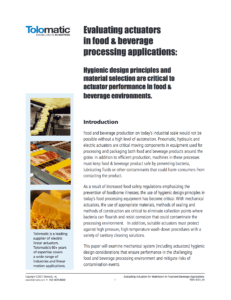Evaluating actuators for washdown in food & beverage applications
Hygienic design principles and material selection are critical to actuator performance in food & beverage environments.
Introduction
Food and beverage production on today’s industrial scale would not be possible without a high level of automation. Pneumatic, hydraulic and electric actuators are critical moving components in equipment used for processing and packaging both food and beverage products around the globe. In addition to efficient production, machines in these processes must keep food & beverage product safe by preventing bacteria, lubricating fluids or other contaminants that could harm consumers from contacting the product.
As a result of increased food safety regulations emphasizing the prevention of foodborne illnesses, the use of hygienic design principles in today’s food processing equipment has become critical. With mechanical actuators, the use of appropriate materials, methods of sealing and methods of construction are critical to eliminate collection points where bacteria can flourish and resist corrosion that could contaminate the processing environment. In addition, suitable actuators must protect against high pressure, high temperature wash-down procedures with a variety of sanitary cleaning solutions.
This paper will examine mechanical system (including actuators) hygienic design considerations that ensure performance in the challenging food and beverage processing environment and mitigate risks of contamination events.
A proactive approach to preventing food contamination
Until recently, the food processing industry handled contamination events reactively. If a foodborne illness was traced back to contamination at a manufacturing plant, the governing agency could fine the manufacturer and require them to fix the problem.
The flaw in this system, though, was that most of these illnesses were preventable. For example in the United States, The Centers for Disease Control and Prevention estimates that 48 million people (1 in 6 Americans) get sick, 128,000 are hospitalized, and 3,000 die each year from foodborne diseases.
The U.S. government stepped in to change the way the FDA and food producers operate with the Food Safety Modernization Act (FSMA) – signed into law in January 2011. This important legislation shifts the focus to preventing contamination problems instead of just responding to them. FSMA affects all automation components used in the industry, including linear actuators. There are similar food safety regulations being enacted globally to address the growing concern of contaminated food sources.
The most critical food and beverage processing applications involve dairy, meat, seafood, and egg production. These critical applications require the most attention to detail with respect to hygienic design and material selection due to higher risk of bacterial contamination and more aggressive wash-down practices. However, there are many other types of processing environments such as bakeries, confectionery, beverage and other less stringent food and beverage processing environments. These less stringent environments will still be cleaned, must withstand corrosion and must prevent growth of bacteria but present some potential trade-offs with hygienic design elements or material selection.
Regardless of the application, a machine designer can mitigate risks by following hygienic design principles and material selection to evaluate each potential component’s ability to withstand cleaningprocedures, avoid corrosion, and eliminate harborage points for bacteria growth. Factors to look for include:
- Designs that shed moisture easily
- Materials of construction that resist corrosion
- Food-safe materials
- IP69k protection of all vital components
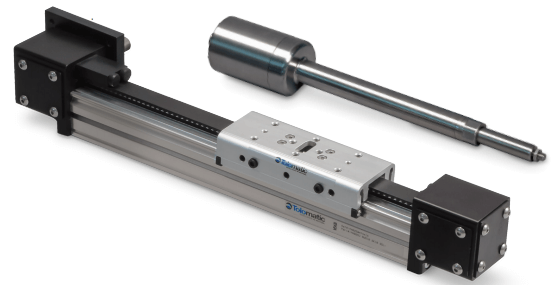
Above are examples two different actuator types: Rod-style and rodless. The inherent sealing properties of the rod-style actuator make it the only logical choice for wash-down environments where actuator shielding is not possible.
Types of Actuators
Machinery used in food and beverage processing may use several types of actuators, including rod-style, rodless or rotary depending on where they are located in the processing equipment and how they are shielded from wash-down processes. The bearing system of a rodless actuator is designed to carry loads throughout the actuator’s stroke preventing the design from being sealed adequately to protect against the ingress of liquids into the actuator. A rodless actuator would have to be well shielded from the wash-down process with stainless steel guarding which adds cost and complexity to the machine design. Even with guarding, risk of ingression into a rodless actuator can not be eliminated. For applications that require the actuator to come in direct contact with wash-down solutions, the rod-style actuator is the only choice due to its ability to seal around the rod. Pneumatic and hydraulic cylinders are widely used in the food and beverage industry due to their low cost points, but electric rod-style actuators are gaining momentum for a variety of reasons including flexibility of control (multiple positions and motion profiles), efficiency (elimination of compressed air) and higher performance (precision, accuracy, repeatability). Additionally, there are contamination risks associated with fluid power cylinders in the food processing environment. With pneumatic cylinders, the air must be kept clean from condensation and other contaminates in the air lines that could cause bacteria growth. With hydraulic cylinders, leaking hydraulic fluid can contaminate product and cause costly delays in production with clean up activities.
While the working parts of a typical rod-style actuator may not ever come in direct contact with the food product or its packaging, there are invariably spills, drips and spatters that collect on various parts of the processing machinery, including the actuators. Unless this residue is removed from the equipment on a regular basis through the cleaning process, it inevitably becomes a bacterial contamination threat to the food product.
Materials suitable for wash-down environments
Actuators used in wash-down environments must be made of corrosion-resistant materials (stainless steel & plastic seals / gaskets) or be carefully shielded to prevent water, food products or chemicals from contacting the actuator. While shielding of more economical actuators not designed for wash-down is widely practiced, shields complicate equipment design and many times interfere with maintenance. Stainless steel constructed actuators designed for wash-down can eliminate the need for shielding making the machine design more open and less complicated to build.
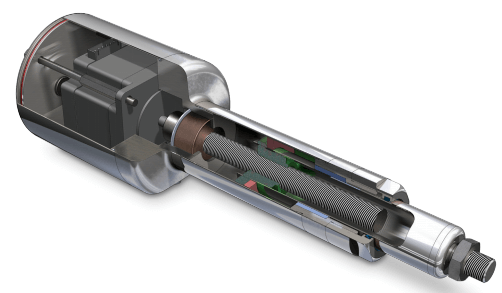
This rod-style actuator is made of all stainless-steel construction and includes a protective motor enclosure. The actuator also employs FDA approved seals for IP69k ingress protection for increased resistance to chemicals, water and dust.
Ideally, actuators used in wash-down environments should be constructed of AISI 300 series stainless steel (excluding type 301 and 302), with 304 and 316 being the most popular. While metal alloys (such as aluminum) other than stainless steel may be suitable under certain conditions, alloys containing lead, leachable copper or other toxic metals must be avoided in food and beverage applications. For example, aluminum alloy as an actuator construction material may be satisfactory for some dry-product processing applications as long as it is not subjected to strong caustic cleaning solutions or to the corrosive action of dissimilar metals. Various surface treatments or coatings may be used to reduce corrosion on components that have product contact, but the coatings need to be approved for food and beverage use by governing regulations. But caution should be taken with the location / placement of these types of actuators because eventually the paint may chip or flake off into the processing environment.
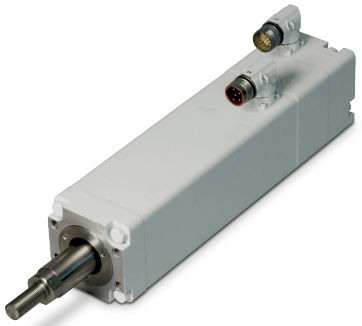
Shown here is Tolomatic’s IMA integrated servo actuator with food grade white epoxy coating and stainless steel rod and mounting hardware. This is a great choice for bakery, confectionery and beverage applications.)
Other parts of the actuator such as seals, gaskets, connectors, cables and lubrication also need to be compatible with food processing environment especially if they are in contact with the product or used over the product processing area. In addition, these seals, gaskets and accessories must be capable of withstanding the effects of the cleaning solutions used and provide proper seal between the actuator body and the rod to either IP67 or IP69k protection rating.
Depending on the region of the world, local governing agencies (FDA or similar) will maintain lists of approved plastic and rubber materials to withstand sanitary wash-down solutions and prevent leakage into the processing environment. There are various material choices but some popular ones are Polyeurathane blends, Viton®, and UHMW. Additionally, lubricants used inside the actuator may migrate to the rod over time. These oils and greases should be approved by the FDA or similar governing body.
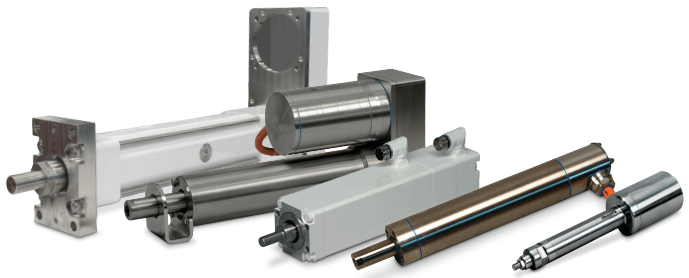
Tolomatic uses food grade grease in all its food & beverage designed electric actuators. This grease has been selected and tested to achieve optimal actuator life.
Design and fabrication
Any mechanical design food and beverage applications needs to be free of crevices that may harbor bacteria, need to be sealed for wash-down (IP69k preferred) and have rounded surfaces with a smooth finish that easily shed moisture. Motor housings, actuator bodies, corners and edges should all be rounded to promote moisture runoff. Generally, a number 4 ground finish or better on stainless steel that is free of pits, cracks, folds or other imperfections is suitable for wash-down applications. For welded junctions, electro-polishing, glass beading and shot peening are not generally acceptable alternatives to a number 4 ground finish.
Permanent joints in the construction of an actuator, should either be welded, sealed with an o-ring or use a gasket. Regardless of the joint construction, the junction should be fully cleanable when assembled and contain no crevices for bacteria to migrate and grow. For example, with the use of gaskets or o-rings, the material should fill the entire gap of the adjacent surfaces to eliminate any crevices or cracks. More standard aluminum actuators tend to have grooves along the screw body to accept position switches would not be suitable for use in a food and beverage application.
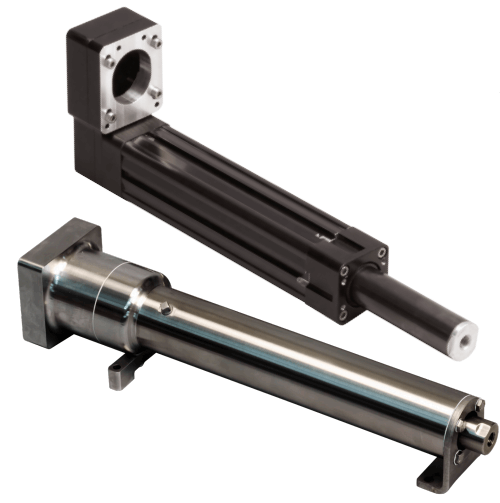
Stainless Steel ERD uses welded seams, gaskets and o-rings to properly fill the mating joints.
Fasteners used on actuators intended for wash-down environments also need to be able to shed water freely. Avoid socket head bolts, counter bored holes, slotted screws or fasteners with knurling as they all have debris collection points. Hex head bolts, acorn nuts or hygienic approved hardware are the preferred choice to eliminate any harborage points. Additionally, avoid fasteners or rod ends with exposed threads where debris can also collect.
Whether an actuator is pneumatic, hydraulic or electric, it must be sealed properly so that dust, drips and wash-down solutions do not contaminate the motor or internal mechanisms. Actuators with an IP65 or IP67 rating are protected against ingress of dust and low-pressure wash-down under static conditions. For extreme wash-down environments, an IP69K rating offers the best protection. While the IP69K rating does not specify protection from chemical attack due to aggressive cleaning solutions, this rating does maintain a high level of ingress protection in high pressure, high temperature wash-down situations.
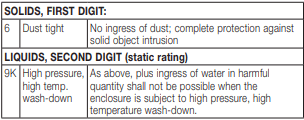
But, with an IP69k designed actuator intended for food & beverage processing, the IP69k designation implies to end-users that the actuator will also be able to withstand wash-down with a variety of cleaning solutions.
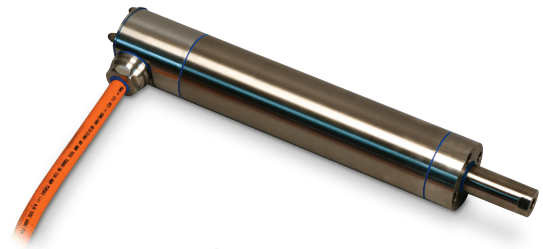
The hygienic design of the IMA-ST with the integrated servo motor includes all the best design practices such as 316 stainless, FDA approved seals / o-rings, welded joints, smooth rounded edges, proper mounting hardware and an IP69k ingress protection rating.
Actuator maintenance
Maintenance of food processing or packaging equipment is vital for proper sanitation and maximum uptime. The harsh wash-down environment is hard on equipment, and it is important to be constantly looking for any evidence of corrosion or less than optimum operation. Actuators, when specifically designed for wash-down environments and properly sized for the application, can be very durable components. However, it is important to periodically inspect actuators for any signs of seal wear along the rod, loose components, pitting or corrosion. Pitting or corrosion can create sites that collect moisture and also harbor debris or bacteria.
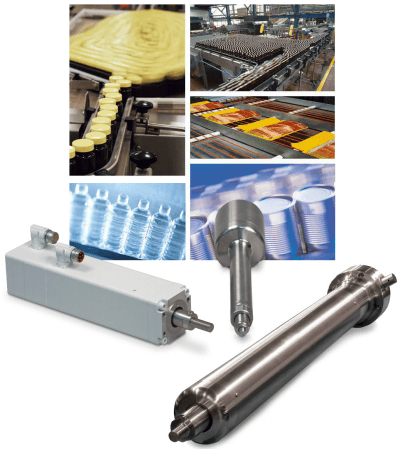
Conclusions
Actuators play an important role in processing and packaging machinery used in the food and beverage industry as they are the primary linear mover. Additionally, the design of actuators used in these applications is critical to the health and safety of the products being produced. Design elements such as material selection, wash-down protection rating, fabrication, joining methods, mounting hardware, part geometries and more are critical to incorporate into any mechanical design including actuators. It is best to choose an actuator designed for the food & beverage processing environment that incorporates as many of the hygienic design elements as possible to meet budget and minimize overall risk of bacteria contamination, corrosion and wash-down protection.
To Learn More:
For information on 3-A Sanitary Standards, go to http://www.3-a.org/. For USDA guidelines on sanitary equipment design, see http://www.ams. usda.gov/services/auditing/equipment

 Ask an Engineer
Ask an Engineer